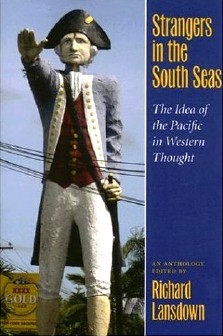|
Strangers
in the South seas : the idea of the Pacific in western thought /
ed. by Richard Lansdown. - Honolulu : University of Hawai'i press,
2006. - XVII-429 p. : ill., maps ; 24 cm.
ISBN 978-0-8248-3042-7
|
|
NOTE DE L'ÉDITEUR
: Long before Magellan entered the Pacific in 1521 Westerners
entertained ideas of undiscovered oceans, mighty continents, and
paradisal islands at the far ends of the earth. First set down by
Egyptian storytellers, Greek philosophers, and Latin poets, such ideas
would have a long life and a deep impact in both the Pacific and the
West. With the discovery of Tahiti in 1767 another powerful myth was
added to this collection : the noble savage.
For the first time Westerners were confronted by a people who seemed
happier than themselves. This revolution in the human sciences was
accompanied by one in the natural sciences as the region revealed gaps
and anomalies in the « great chain of being »
that Charles Darwin would begin to address after his momentous visit to
the Galapagos Islands.
The Pacific produced similar challenges
for nineteenth-century researchers on race and culture, and for those
intent on exporting their religions to this immense quarter of the
globe. Although most missionary efforts ultimately met with success,
others ended in ignominious retreat. As the century wore on, the region
presented opportunities and dilemmas for the imperial powers, leading
to a guilty desire on the part of some to pull out, along with an
equally guilty desire on the part of others to stay and help. This
process was accelerated by the Pacific War between 1941 and 1945. After
more than two millennia of fantasies, the story of the West's
fascination with the insular Pacific graduated to a marked sense of
disillusion that is equally visible in the paintings of Gauguin and the
journalism of the nuclear Pacific.
Strangers in the South Seas
recounts and illustrates this story using a wealth of primary texts. It
includes generous excerpts from the work of explorers, soldiers,
naturalists, anthropologists, artists, and writers — some
famous, some obscure. It begins in 1521 with an account of Guam by
Antonio Pigafetta (one of the few men to survive Magellan's
circumnavigation voyage), and ends in the late 1980s with the writing
of an American woman, Joana McIntyre Varawa, as she faces the personal
and cultural insecurities of marriage and settlement in Fiji. It shows
how « the Great South Sea » has been an
irreplaceable « distant mirror » of the West and
its intellectual obsessions since the Renaissance.
Comprehensively
illustrated and annotated, this anthology will introduce readers to a
region central to the development of modern Western ideas.
Richard Lansdown is associate professor in English at James Cook University, Cairns, Australia.
|
SARAH MOHAMED-GAILLARD : Par cette anthologie, Richard Lansdown (…) poursuit un sillon
déjà entamé par les travaux de Jonathan Lamb,
Vanessa Smith et Nicholas Thomas (2001), de Jean-Jo Scemla
(2002) ou d'Etienne Taillemite (2006). Le projet de l’auteur est
clair. Il n'entend pas déconstruire « les distorsions
imaginaires des Occidentaux qui ont visité le
Pacifique » mais plutôt les compiler afin de
« les identifier pour ce qu'elles sont et pour comprendre
plus facilement les origines intellectuelles et imaginaires des
interventions européennes et américaines dans le
Pacifique insulaire » (p. 17). Cette ambition est
d'ailleurs mise en œuvre dès l’introduction qui
s’impose comme une synthèse réussie de
l’histoire de l’Océanie de son peuplement à
la colonisation en passant par l’entrée des navigateurs
occidentaux dans l’océan Pacifique.
(…)
Dans
cette anthologie qui s’étend de la relation de Magellan
(1522) à l’évocation des îles Marquises par
le romancier américain Larry McMurtry (2001), Richard Lansdown
présente des extraits d’œuvres souvent
évoquées telles celles de Daniel Defoe, James Cook,
George Forster, Louis-Antoine de Bougainville, Charles Darwin, Herman
Melville … mais, a aussi le mérite de proposer des
écrits moins connus du grand public tels ceux des missionnaires
de la London Missionary Society ou de l’anthropologue
français Joseph-Marie De Gérando.
Si nous pouvons
regretter l’abondance de textes anglo-saxons et français
au détriment d’autres sources plus inédites,
notamment allemandes ou hollandaises, la lecture de cette anthologie
est toutefois à conseiller à ceux souhaitant retourner
aux sources de la construction occidentale de l’Océanie,
et plus particulièrement aux étudiants.
→ Sarah Mohamed-Gaillard (INALCO, Paris) — Journal de la Société des océanistes, 126-127 | 2008 (Spécial Environnement dans le Pacifique, pp. 338-339
|
|
| mise-à-jour : 23 décembre 2008 |

| |
|